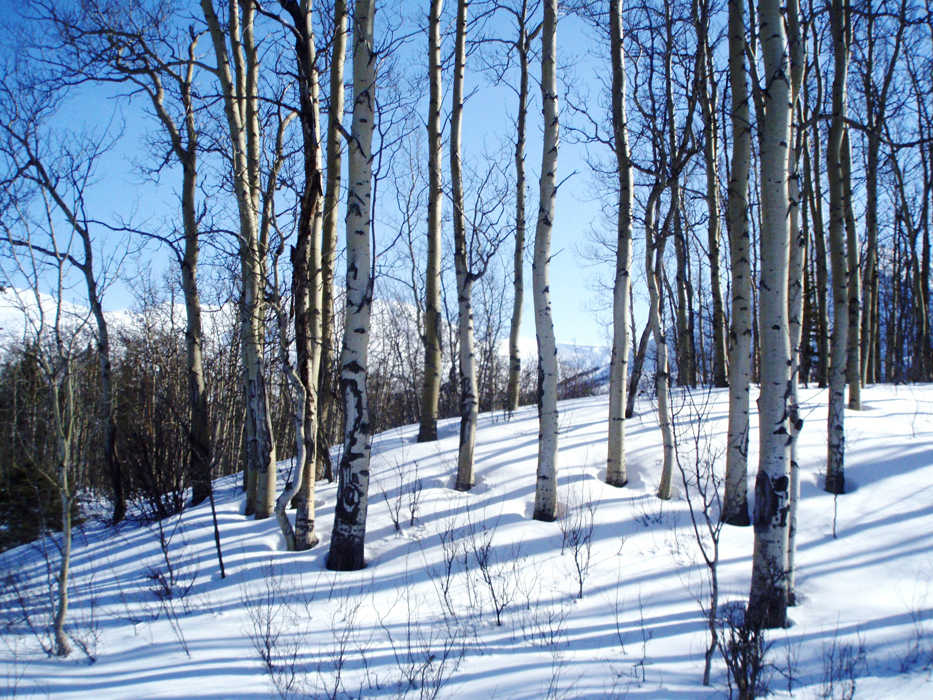From the warmth of my office, the view includes a magnificent stand of quaking aspens along the ridge near Headquarters Lake. During particularly frosty days as we’ve recently experienced, I always wonder how these seemingly delicate and graceful trees manage to survive the long darkness and the deep cold typical for this time of year.
Quaking aspen is known variously by many names, including trembling aspen, golden aspen, mountain aspen, popple, poplar, and trembling poplar. Here on the Kenai Peninsula, stunning quaking aspen stands can be seen along the highway on the way through Cooper Landing, with close encounters on many trails such as the Kenai River Trail or the Skyline Trail on the Kenai National Wildlife Refuge. Many neighborhoods are nestled in small stands of quaking aspen too.
Roughly one third of the land area is forested on the peninsula, and of that, over sixty percent is coniferous forest. Pure aspen stands make up only a small percentage of the deciduous forests, but mixed forests of spruce and hardwoods comprise close to thirty percent of our forests. Though the percentage is small here, quaking aspen is the most widely distributed tree in North America, and the second most widely distributed in the world.
Quaking aspen is well-adapted to the cold through some typical tree strategies, and one very special one. For plants, the secret to survival in high latitudes is to stay small. Trees are no exception, generally growing smaller further north, limited by cold tolerance or moisture availability. In higher elevations the same principle applies, with shorter, stunted versions of trees that are full grown several hundred feet down the mountain.
Quaking aspen maximum height is only around 80 feet in Alaska, with more common heights around 50 feet. Some trees can live to be close to 200 years old, but generally the upper age limit is around 80 years.
Aspen commonly grows in multi-stemmed clones. Aspen can reproduce by root sprouts, or suckers, after only one year of age, a handy adaptation in marginal climates. The propensity for root sprouting can form large clones whose leaves all change color at the same time in the fall, or leaf out at the exact same time in the spring. Some aspen stands are thought to be thousands of years old, originating from one tree.
In addition to vegetative reproduction, the aspen covers all its reproductive bases by producing seed crops every four or five years, pollinated by wind. The seeds have long silky hairs to cover vast distances, which helps reestablish stands after disturbances. Aspen is often the first tree to reappear and aggressively colonize after a disturbance such as a landslide or a wildfire.
Severe fire can kill aspen, but stands of this tree serve as an excellent fire break because little fuel accumulates in them. Overwinter freezing can cause frost cracks, and hail can damage young stands of trees in particular. Drought is thought to be hard on this species. At higher elevations, such as along the Skyline Trail, the growth form can be stunted.
Hares and beavers like to eat the young sprouts, and moose can damage trees by “barking” them with their incisors. Moose also rub their antlers on the bark, causing damage. These injuries can invite secondary attacks by insects or diseases, such as shoot blight, a variety of stem cankers, or leaf rust fungi. Minor damage can be caused by grouse, which feed on the buds in the spring, and leaves in the summer.
With so many fragilities, why is quaking aspen so persistent and widespread? The tree’s ability to thrive in what is otherwise mainly a conifer-dominated high-elevation, high-latitude realm is the unique characteristic of its bark. The living bark layer contains chlorophyll and can carry out photosynthesis, a task usually reserved for tree leaves.
In winter, when other deciduous trees are mostly dormant, quaking aspens keep producing sugar for energy. Trees found growing in higher elevations or more northern latitudes tend to have greener bark with higher chlorophyll levels as an adaptation to cold winter temperatures. Older trees develop grayish, furrowed bark.
Why does the aspen quake? The leaf stalk is flattened, and set perpendicular to the surface of the leaf, which makes the foliage susceptible to the slightest movement of air. This adaptation allows the leaf to twist easily, offering resistance to wind damage. This structure may also improve the photosynthetic rate, by allowing more light through to inner leaves throughout the day.
The aspen is well-represented in literature and stories stretching back centuries. In the 1600s, a poem likened the constant fluttering of leaves to the tongues of malicious gossipers, “prest to wave with every wind.” In folklore, the quaking aspen was a haughty tree. When the Great Spirit came to visit the forest, all the forest creatures trembled and shook with fear and reverence except the aspen. The Great Spirit was offended, and declared that henceforth whenever anyone looked at it, the aspen would quake and tremble in deference.
No matter what time of year, the quaking aspen provides a striking contrast to our darker conifer forests. On your next journey through the winter woods, take time to contemplate the hidden hardiness of this remarkable tree.
Elizabeth Bella is the vegetation ecologist at the Kenai National Wildlife Refuge. Visit http://www.fws.gov/refuge/kenai/ for more information about the Refuge.

